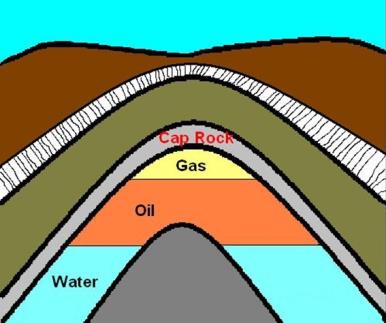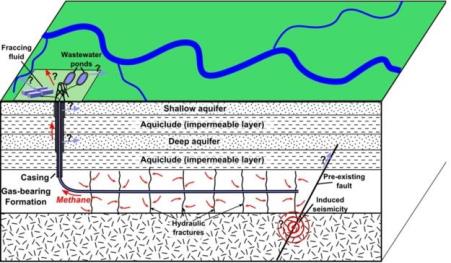Petroleum Reservoir Drilling
Petroleum reserves are often stored in porous rock layers such as limestone or sandstone capped by an impermeable layer of rock often a mile or two below the surface as shown in the figure below.
A well can be drilled down to the reservoir and the oil can naturally flow out due to the overburden pressure of the surrounding rock layers, or it can be actively pumped out. In either case the porosity of the material allows for a large volume of oil as well as many easy channels were it can flow out through. However, these pores and channels become low pressures zones after oil extraction and the resulting overburden should subside to fill in this space. Due to the deep nature of these reservoirs, however, the amount of subsidence at the surface should be small and widely spread out.
In other cases the oil can be trapped in a non-permeable rock layer, such as shale, which does not allow for easy flow of the oil once the well has been tapped. In this case conventional wells are impractical. One method of solving this problem is hydraulic fracturing. A fluid (composed primarily of water and sand, with trace amounts of other chemicals) is forced into a well shaft at high pressure (see figure 2). This results in upheaval and fracturing of the rock layers, opening up channels through which the oil and gas can flow. Sand particles in the fluid are used to then prop open these channels. At this point the well may be pump conventionally. One would expect that creating such a high pressure region underground could result in uplift of the surface layers.
The large pressure differentials associated with pumping and fracturing should result in surface deformations. These have been shown to lead to increased swarm seismicity (Keranan 2014). But the deformation itself may also be useful for studying the well, the reservoir, or the surrounding rock layers and maybe be useful information for petroleum engineers, the oil companies, and people living near areas of heavy drilling and fracturing.



